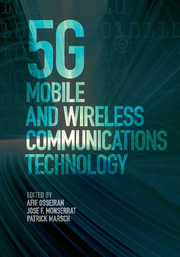Book contents
- Frontmatter
- Dedication
- Contents
- List of contributors
- Foreword
- Acknowledgments
- Acronyms
- 1 Introduction
- 2 5G use cases and system concept
- 3 The 5G architecture
- 4 Machine-type communications
- 5 Device-to-device (D2D) communications
- 6 Millimeter wave communications
- 7 The 5G radio-access technologies
- 8 Massive multiple-input multiple-output (MIMO) systems
- 9 Coordinated multi-point transmission in 5G
- 10 Relaying and wireless network coding
- 11 Interference management, mobility management, and dynamic reconfiguration
- 12 Spectrum
- 13 The 5G wireless propagation channel models
- 14 Simulation methodology
- Index
- References
9 - Coordinated multi-point transmission in 5G
Published online by Cambridge University Press: 05 June 2016
- Frontmatter
- Dedication
- Contents
- List of contributors
- Foreword
- Acknowledgments
- Acronyms
- 1 Introduction
- 2 5G use cases and system concept
- 3 The 5G architecture
- 4 Machine-type communications
- 5 Device-to-device (D2D) communications
- 6 Millimeter wave communications
- 7 The 5G radio-access technologies
- 8 Massive multiple-input multiple-output (MIMO) systems
- 9 Coordinated multi-point transmission in 5G
- 10 Relaying and wireless network coding
- 11 Interference management, mobility management, and dynamic reconfiguration
- 12 Spectrum
- 13 The 5G wireless propagation channel models
- 14 Simulation methodology
- Index
- References
Summary
Introduction
The performance of a wireless network strongly depends on the user positions in a cell. More precisely, the UEs (User Equipments) at the cell border typically experience much lower throughput than those nearer to the transmitting Base Station (BS). This is mainly due to the presence of inter-cell interference, generated by concurrent transmissions in other cells. Inter-cell interference is particularly relevant for modern wireless communication systems like Universal Mobile Telecommunications System (UMTS) or Long-Term Evolution (LTE), and also 5G, where the frequency reuse factor is one or very close to one. In such scenario the system is primarily interference limited, and the performance cannot be improved by simply increasing the transmitted power. Hence, techniques are necessary in order to (1) target inter-cell interference and (2) reduce the gap between the cell edge and average throughput. Consequently, these alternative techniques allow a more even user experience throughout the whole network.
In principle, the following techniques can be pursued to tackle inter-cell interference:
• Interference can simply be treated as white noise. This is clearly suboptimal, as it ignores properties of the interfering signals that could be exploited in order to improve signal reception quality.
• Interference can be avoided through statically leaving some transmit resources in some cells muted (e.g. fractional frequency reuse), or otherwise constraining the usage of resources, or through coordinated scheduling among cells, as investigated in Chapter 11.
• The impact of interference can be alleviated at the receiver side through e.g. Interference Rejection Combining (IRC), where multiple receive antennas and subsequent receive filters are used to attenuate the interference to a certain extent.
• Interference may be decoded and cancelled, a technique that is for instance studied in 3GPP in the context of Network-Assisted Interference Cancelation (NAIC).
• At the transmitter side, interference can also be partially avoided by performing interference-aware precoding, i.e. applying precoding such that the interference caused toward adjacent cells is reduced.
• Ultimately, signals from other cells can in fact be treated as a useful signal energy instead of interference, if (in the downlink) multiple nodes jointly transmit signals that coherently overlap at the intended receiver, and destructively overlap at interfered receivers. In the uplink (UL), multiple nodes can jointly receive and decode the signals from multiple UEs, and in this form also exploit interference rather than seeing it as a burden.
- Type
- Chapter
- Information
- 5G Mobile and Wireless Communications Technology , pp. 248 - 276Publisher: Cambridge University PressPrint publication year: 2016
References
- 8
- Cited by

